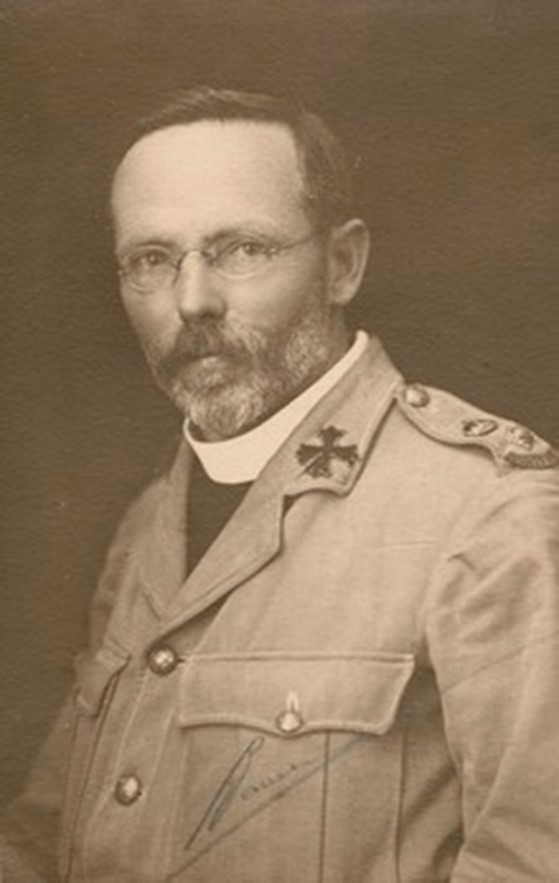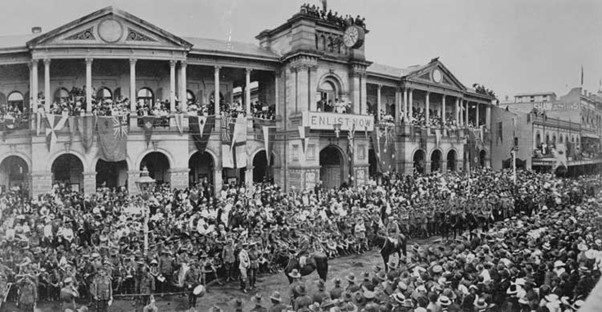 The catch cry of Canon David Garland was “nothing is too good for our soldier boys”. It epitomises the heart of a man dedicated to the soldiers he served. Born in Ireland in 1864, Garland migrated to Australia at the age of 22. He successfully advocated for the introduction of religious education in schools, which became law in WA in 1893 and later in QLD in 1910. He began as an army chaplain to those about to embark for the Boer War in 1896. In 1915 he was appointed Senior Chaplain to the Queensland Expeditionary Forces, made an honorary Lieutenant Colonel and served at the training camps in Enoggera Army Base, whilst also running a parish.
The catch cry of Canon David Garland was “nothing is too good for our soldier boys”. It epitomises the heart of a man dedicated to the soldiers he served. Born in Ireland in 1864, Garland migrated to Australia at the age of 22. He successfully advocated for the introduction of religious education in schools, which became law in WA in 1893 and later in QLD in 1910. He began as an army chaplain to those about to embark for the Boer War in 1896. In 1915 he was appointed Senior Chaplain to the Queensland Expeditionary Forces, made an honorary Lieutenant Colonel and served at the training camps in Enoggera Army Base, whilst also running a parish.
His concern was to make life better for those who had volunteered to go to war. He directed the ‘Soldiers’ Help Society’ to assist the troops. Whilst serving in the Middle East in 1918-1919, he established eight clubs to give the soldiers an alternative to pubs and brothels. He became the first Chaplain to conduct Holy Communion in the Church of the Holy Sepulchre in Jerusalem. He acknowledged the contribution and sacrifices of the Light Horsemen in a report about their work in Egypt, Palestine, and Syria:
“Our troops here have made a magnificent contribution. It is not too much to say that the collapse of the enemy throughout the world was at least hastened by the cavalry featwhich, sweeping Palestine and Syria in a manner unknown in history, ensured Turkey’s break-away from Germany. I fear that the hardships endured and the magnificent fighting done by the Australian Light Horse have not been fully realised in Australia, and yet it may safely be said that nowhere had our Australian soldiers harder conditions or more strenuous fighting or less relaxation and comforts, which facts make our work all the more necessary.”1
Always an advocate for aboriginal rights, he recruited the first aboriginal half-castes to the army as soon as the government allowed them to join. He was the honorary secretary to the ANZAC Day Commemoration Committee of Queensland. In January 1916, the committee and people endorsed 25th April as ANZAC Day and Garland was primarily given the difficult task of creating the format for a service that would be acceptable to the various religious, military, government, business and community groups. He carefully selected hymns, odes and poems that would be acceptable to the wide variety of parties and included the minute’s silence.
After the war, he was active in establishing public war memorials and initiated ANZAC ribbons which were sold to provide funds to build the war memorials and for the upkeep of soldiers’ graves as well as assisting returned veterans. He initiated the ANZAC Day marches, the first of which was held in Brisbane on April 25, 1916 with 8,000 men marching through the streets. He lobbied for ANZAC Day to become a public holiday in all states which he achieved by 1930. His selfless and untiring work for the soldiers, their families and the community were recognised in 1934 when he was awarded an OBE for his services to the community. He died in 1934, aged 75.
 |
Garland was filled with a deep desire that the troops’ efforts were not to be forgotten. He admired the sacrificial service of the volunteers but bemoaned that society as a whole did not embrace this attitude.
There must be an expansion of the spirit of sacrifice; it must go deeper and wider until it permeates Australia as a people. The two lessons I think we most need to learn are unselfishness and self-denial.2
These echo the ANZAC values of sacrifice and mateship. Today they are needed more than ever. We are privileged to live in a free nation because of the sacrifice of those who have gone before. Let us truly honour and appreciate the price they paid for our freedom.
Footnotes:
- http://www.garlandmemorial.com/category/the-journey/at-the-front/ – from page 9, “The Brisbane Courier” newspaper of 30 April 1919.
- http://www.garlandmemorial.com/category/the-journey/the-garland-wartime-columns/garland-columns/ Quote from David J. Garland, Resident Chaplain, Director, Soldiers’ Church of England Help Society. 18 November, 1916. – from page 235 of “The Church Chronicle” monthly journal (Church England, Diocese of Brisbane) of 1 December 1916.
Pictures:
- http://blogs.slq.qld.gov.au/ww1/tag/anzac-day/- John Oxley Library, State Library of Queensland Image: 28069-0001-000
- First ANZAC Day March Brisbane 25 April, 1916 National Archives of Australia Ref J2879, QTH173,http://vrroom.naa.gov.au/print/?ID=19356
References:
http://www.garlandmemorial.com
http://adb.anu.edu.au/biography/garland-david-john-6278 Wendy M Mansfield, ‘Garland, David John (1864-1939)’, Australian Dictionary of Biography, National Centre of Biography, Australian University, http://adb.anu.au/biography/garland-david-john-6278/text10821, published first in hardcopy 1981, accessed online 13 June 2016. This article was first published in hardcopy in Australian Dictionary of Biography, Vol 8 (MUP), 1981.
https://www.csu.edu.au/__data/assets/pdf_file/0007/789226/Moses.pdf
sjks.org.au/wp-content/uploads/2015/04/Moses-Canon-David-Garland.pdf
https://en.wikipedia.org/wiki/David_John_Garland
PowerPoint:
![]() Architect_of_Anzac_Day_ppt_-_ch.pptx
Architect_of_Anzac_Day_ppt_-_ch.pptx
